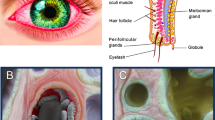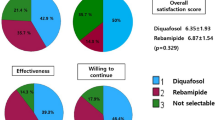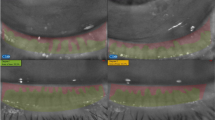Abstract
Purpose
To investigate the efficacy of lid wipes (LWs) containing terpinen-4-ol and sodium hyaluronate (Hy-ter®) for the treatment of seborrheic blepharitis compared to baby shampoo (BS).
Methods
This randomized, double-blind, active control, parallel group, multicentre clinical trial included 48 eyes of 48 patients with seborrheic blepharitis who were randomly divided into two treatment arms (1:1, n = 24) using block randomization. LWs or BS were prescribed twice a day for 8 weeks followed by a discontinuation period of 4 weeks. Change in Blepharitis Symptom measure (BLISS), Schirmer’s test, tear breakup time (TBUT), noninvasive TBUT (NI-TBUT), ocular surface disease index (OSDI) score, corneal and conjunctival staining, meibography, and Demodex count at different visits (Baseline, 4th, 8th, and 12th week) were the main outcome measures.
Results
The baseline values of both groups were similar (p > 0.05). Despite high clinical efficacy in both treatment arms, patients using LWs showed a lower BLISS score at the 8th and 12th-week visit (1.9 ± 2.2 versus 7.2 ± 6.6, p = 0.003; 4.0 ± 1.3 versus 5.8 ± 6.3, p = 0.026). NI-TBUT showed a significant increase starting from the 4th week for patients using LWs and 8th week for patients using BS. Both treatment modalities caused a reduction in the Demodex count after 4 weeks of treatment (p < 0.001). The treatment withdrawal did not cause any recurrence in both treatment arms.
Conclusion
BS or LWs containing Hy-ter® can be used with good efficacy for the treatment of seborrheic blepharitis. However, LWs may provide a better symptomatic relief compared to BS after 8 weeks of treatment.
Similar content being viewed by others
Login or create a free account to read this content
Gain free access to this article, as well as selected content from this journal and more on nature.com
or
References
McCulley JP, Dougherty JM, Deneau DG. Classification of chronic blepharitis. Ophthalmology. 1982;89:1173–80.
Amescua G, Akpek EK, Farid M, Garcia-Ferrer FJ, Lin A, Rhee MK, et al. Blepharitis preferred practice pattern®. Ophthalmology. 2019;126:P56–93.
Ficker L, Ramakrishnan M, Seal D, Wright P. Role of cell-mediated immunity to staphylococci in blepharitis. Am J Ophthalmol. 1991;111:473–9.
Lindsley K, Matsumura S, Hatef E, Akpek EK. Interventions for chronic blepharitis. Cochrane Database Syst Rev. 2012:CD005556. https://doi.org/10.1002/14651858.CD005556.pub2.
Demircan A, Altan C, Azman FE, Alkin Z, Kucuksumer Y, Demirok A. Tear properties in eyes with chronic blepharitis. Turk J Ophthalmol. 2012;42:346–8.
Murphy O, O’Dwyer V, Lloyd-McKernan A. The efficacy of tea tree face wash, 1, 2-Octanediol and microblepharoexfoliation in treating Demodex folliculorum blepharitis. Contact Lens Anterior Eye. 2018;41:77–82.
De Luca V, Carnevali A, Carnovale Scalzo G, Piccoli G, Bruzzichessi D, Scorcia V. Efficacy and safety of wet wipes containing Hy-Ter® solution compared with standard care for bilateral posterior blepharitis: a preliminary randomized controlled study. Ophthalmol Ther. 2019;8:313–21.
Salem DAB, El-shazly A, Nabih N, El-Bayoumy Y, Saleh S. Evaluation of the efficacy of oral ivermectin in comparison with ivermectin-metronidazole combined therapy in the treatment of ocular and skin lesions of Demodex folliculorum. Int J Infect Dis. 2013;17:e343–7. https://doi.org/10.1016/j.ijid.2012.11.022.
Muntz A, Sandford E, Claassen M, Curd L, Jackson AK, Watters G, et al. Randomized trial of topical periocular castor oil treatment for blepharitis. Ocul Surf. 2021;19:145–50.
Hecht I, Melzer-Golik A, Sadi Szyper N, Kaiserman I. Permethrin cream for the treatment of demodex blepharitis. Cornea. 2019;38:1513–8.
Navel V, Mulliez A, Benoist d’Azy C, Baker JS, Malecaze J, Chiambaretta F, et al. Efficacy of treatments for Demodex blepharitis: a systematic review and meta-analysis. Ocul Surf. 2019;17:655–69.
Sung J, Wang MTM, Lee SH, Cheung IMY, Ismail S, Sherwin T, et al. Randomized double-masked trial of eyelid cleansing treatments for blepharitis. Ocul Surf. 2018;16:77–83.
Gao YY, Xu DL, Huang LJ, Wang R, Tseng SCG. Treatment of ocular itching associated with ocular demodicosis by 5% tea tree oil ointment. Cornea. 2012;31:14–17.
Anon. The definition and classification of dry eye disease: report of the definition and classification subcommittee of the International Dry Eye WorkShop (2007). Ocul Surf. 2007;5:75–92.
Hosseini K, Bourque LB, Hays RD. Development and evaluation of a measure of patient-reported symptoms of Blepharitis. Health Qual Life Outcomes. 2018;16:11. https://doi.org/10.1186/s12955-018-0839-5.
Gao YY, Di Pascuale MA, Li W, Liu DTS, Baradaran-Rafii A, Elizondo A, et al. High prevalence of Demodex in eyelashes with cylindrical dandruff. Investig Ophthalmol Vis Sci. 2005;46:3089–94.
Rather PA, Hassan I. Human demodex mite: the versatile mite of dermatological importance. Indian J Dermatol. 2014;59:60–6.
Hirsch-Hoffmann S, Kaufmann C, Bänninger PB, Thiel MA. Treatment options for demodex blepharitis: patient choice and efficacy. Klin Monbl Augenheilkd. 2015;232:384–7.
Alver O, Kıvanç SA, Akova-Budak B, Tüzemen NÜ, Ener B, Özmen AT. A clinical scoring system for diagnosis of ocular demodicosis. Med Sci Monit. 2017;23:5862–9.
Epstein IJ, Rosenberg E, Stuber R, Choi MB, Donnenfeld ED, Perry HD. Double-masked and unmasked prospective study of terpinen-4-ol lid scrubs with microblepharoexfoliation for the treatment of demodex blepharitis. Cornea. 2020;39:408–16.
Fulk GW, Murphy B, Robins MD. Pilocarpine gel for the treatment of demodicosis—a case series. Optom Vis Sci. 1996;73:742–5.
Behrens-Baumann W, Niederdellmann C, Jehkul A, Kohnen R. Bibrocathol-augensalbe ist wirksam bei blepharitis. Ergebnisse einer randomisierten, doppelblinden, kontrollierten klinischen Stud Ophthalmol. 2006;103:960–5.
Hart PH, Brand C, Carson CF, Riley TV, Prager RH, Finlay-Jones JJ. Terpinen-4-ol, the main component of the essential oil of Melaleuca alternifolia (tea tree oil), suppresses inflammatory mediator production by activated human monocytes. Inflamm Res. 2000;49: 619–26. https://pubmed.ncbi.nlm.nih.gov/11131302/. Accessed 3 Dec 2020.
Wieslander G, Norbäck D. Ocular symptoms, tear film stability, nasal patency, and biomarkers in nasal lavage in indoor painters in relation to emissions from water-based paint. Int Arch Occup Environ Health. 2010;83:733–41.
Zirwas M, Moennich J. Shampoos. Dermatitis. 2009;20:106–10.
Liu J, Sheha H, Tseng SCG. Pathogenic role of Demodex mites in blepharitis. Curr Opin Allergy Clin Immunol. 2010;10:505–10.
Lee SH, Chun YS, Kim JH, Kim ES, Kim JC. The relationship between demodex and ocular discomfort. Investig Ophthalmol Vis Sci. 2010;51:2906–11.
Arici MK, Sümer Z, Toker MI, Erdoǧan H, Topalkara A, Akbulut M. The prevalence of Demodex folliculorum in blepharitis patients and the normal population. Ophthalmic Epidemiol. 2005;12:287–90.
Putnam CM. Diagnosis and management of blepharitis: an optometrist’s perspective. Clin Optom. 2016;8:71–8.
Acknowledgements
KUTTAM provided baby shampoo and lid wipes and their blinded box and bottles for the study.
Author information
Authors and Affiliations
Contributions
CA was responsible for the study hypothesis, study design, interpretation of the results, literature review, writing the manuscript, and critical review of the manuscript. BM was responsible for extracting and analyzing data, reviewing the literature, and writing the manuscript. AS was responsible for the study hypothesis, study design, interpretation of the results, literature review, writing a part of the manuscript, and critical review of the manuscript. AYT was responsible for extracting data, reviewing the literature, and writing a part of the manuscript. HBT, ET, and YOB were responsible for microbiological examinations, reviewing the literature, and writing a part of the manuscript.
Corresponding author
Ethics declarations
Competing interests
The authors declare no competing interests.
Additional information
Publisher’s note Springer Nature remains neutral with regard to jurisdictional claims in published maps and institutional affiliations.
Supplementary Information
Rights and permissions
About this article
Cite this article
Arici, C., Mergen, B., Yildiz-Tas, A. et al. Randomized double-blind trial of wipes containing terpinen-4-ol and hyaluronate versus baby shampoo in seborrheic blepharitis patients. Eye 36, 869–876 (2022). https://doi.org/10.1038/s41433-021-01642-7
Received:
Revised:
Accepted:
Published:
Issue Date:
DOI: https://doi.org/10.1038/s41433-021-01642-7



